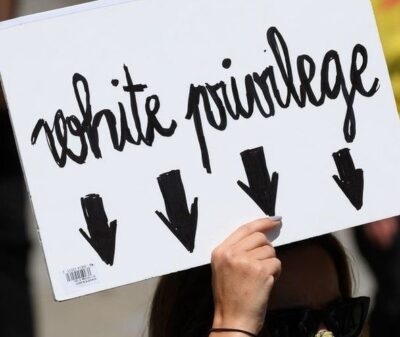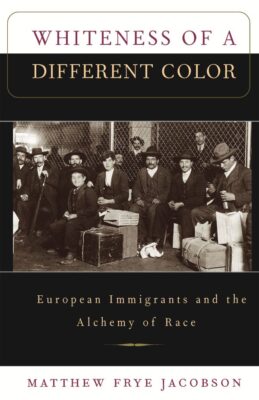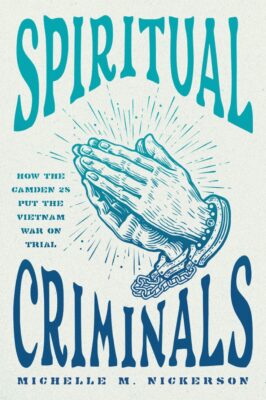Editor's Note
Post #5 in an ongoing series related to Michelle Nickerson’s Spiritual Criminals.
At two points in her story on the Camden 28, Michelle Nickerson takes on a thorny topic: racial privilege. It is indexed in Spiritual Criminals as “white privilege.” In the historical circumstances of the book, and in the larger context of the Catholic-Christian faith, let’s call it ‘white Christian privilege’. Framing it this way helps to distinguish it from the anti-Vietnam War protests by not only citizens of color, but also those who professed Islam, Hinduism, Judaism, Buddhism, atheism, or allegiance to the Nation of Islam. Christianity afforded an additional layer of privilege that protected white Camden 28 activists from certain kinds of dangers.
 Privilege functions on many planes. There are numerous variations. Generally speaking, privilege insulates one from knee-jerk reactions, assumptions, harmful associations (biases), ridicule, and risks. An obvious plane of privilege is the body. It offers many sub-variations of positive and negative associations. Body types generate assumptions. Height enables some kinds of authority. Your gender might enable comfort or caution with other people. Your weight or fitness may call to mind, for some, assumptions about ability, disability, health, laziness, and work ethic. Skin color activates, for some, a range of tribal feelings and so-called instincts. The acts of a privileged person—i.e., one whose body is deemed safe—are interpreted more generously. Danger and law-breaking are not immediately associated with you. Your mere presence will not alarm others.
Privilege functions on many planes. There are numerous variations. Generally speaking, privilege insulates one from knee-jerk reactions, assumptions, harmful associations (biases), ridicule, and risks. An obvious plane of privilege is the body. It offers many sub-variations of positive and negative associations. Body types generate assumptions. Height enables some kinds of authority. Your gender might enable comfort or caution with other people. Your weight or fitness may call to mind, for some, assumptions about ability, disability, health, laziness, and work ethic. Skin color activates, for some, a range of tribal feelings and so-called instincts. The acts of a privileged person—i.e., one whose body is deemed safe—are interpreted more generously. Danger and law-breaking are not immediately associated with you. Your mere presence will not alarm others.
Related to the body, attire can generate, or signal, privilege. Clothing may indicate your gender or religious preferences. Your garb and personal effects present you ways that creates associations and assumptions. A certain level of attire creates or negates privilege. Stepping outside of mainstream attire invokes judgments about norms. In the 1960s, for example, those who dressed in a bohemian style, or who wore “hippie” clothes, broke middle-class norms and were judged accordingly. Sometimes those judgments were desired; the provocation was intentional.
In relation to American religious norms, a person wearing the garb of a priest or nun might activate anti-Catholicism in some spaces. Beginning the mid-twentieth century and after, it might also enable respect—invoking Christian-Catholic privilege. That attire might privilege the wearer’s voice or moral position. Pictures of priests and nuns, in their collars and habits, while advocating for civil rights added a level of sanctity to their actions. A few of Nickerson’s more striking images in Spiritual Criminals demonstrate this kind of religious privilege, especially one of nuns at Selma (p. 45) and Father Michael Doyle preparing ashes (p. 135). One image is notable for how religious figures of the Camden 28 (Milo Billman, Peter Fordi, and Michael Doyle) are stripped of their garb and shown in mugshots as common criminals (p. 99). They had clearly surrendered, or used, their privilege for a cause.
Another plane of privilege arises in conversation. One’s voice may generate a range of doubts or assurances. Your tone, accent, diction, volume, and topics of conversation will garner some privilege—or cause you to lose it. Conversation enables others to learn about your institutional, political, geographical, and class affiliations. Southern accents are, for example, not well-respected in the North. Some of my friends (and frenemies) described my former western Missouri accent/dialect as “hick” (i.e., not even good enough to be a Southern accent!). That tendency has since been scrubbed for my persona courtesy of years in academia. Gendered voices also affect privilege. Women’s voices are not always given outright respect in cultural and social arenas were the patriarchy reigns (e.g., in some religious circles). On the other hand, silence also enables assumptions. Silence might allow others to project their own subjectivities on to you. The ability to remain silent is a privilege, afforded to some and denied others.
The cultural conditions regarding the generation of assumptions, associations, and reactions are endless in relation to privilege. Historians have, of course, attempted to examine, and sometimes combat, various privileges that have arisen in the past. The most famous (or notorious) categories of analysis are race, class, and gender. Others studied include religion, ableism, ethnicity, sexuality, geography, etc. Whether obtained by genetics or social inheritance, there can be no doubt that implicit and explicit privileges exists.

The cover of Matthew Frye Jacobson’s 1999 book, *Whiteness of a Different Color: European Immigrants and the Alchemy of Race*
The idea of racial privilege riles Americans still. It is only in the period from 1950s to the present that certain nationalities and ethnicities have been assimilated into the idea of whiteness (and then re-racialized as ‘Caucasian’, argued Matthew Frye Jacobson). Some aspects of “white privilege,” then, have been only recently accrued by some groups. That said, not all prior national and ethnic prejudices behind the formation of our current ideas of whiteness have disappeared. Some have arisen again after a period of relative dormancy (i.e., antisemitism). Before this relatively new period of whiteness/Caucasion-ness, your Irishness, southern European origins, Jewishness, German-ness, and Slavic-ness would alarm those with so-called “Anglo-Saxon” origins. This is why, in the larger story of American history, we talk about “White Anglo-Saxon Protestant” elitism and privilege.[1] The epithet of “WASPiness” lost some of its sting in the period from the 1950s to 1980. We now deal primarily with different iterations of racial and ethnic prejudice, such as raw anti-Blackness, anti-Hispanic/Latino prejudice, anti-Middle Eastern fears, and anti-Asian sentiments (colorism lies at the base of some of these).
Just after the presidential election Barack Obama—and in part due to his election—some present-day observers proposed that the United States had finally created a “post-racial society.” They argued that we had definitively moved past the civil rights era. With that came a denial, in some corners, of any fundamental problem with unconscious/implicit bias, structural racism, or general racism. This sentiment persisted among both liberal and conservative crowds for a short period of time. But it lasted only a few years, until after the prominent killings of Black Americans there arose the #BlackLivesMatter movement. Even Obama himself would speak out against the notion of a post-racial society in the second term of his presidency. After 2020, only a minority of Americans denied the persistence of racism.
While that post-racial idea existed, there came about a line of reactionary thought, arguing that anyone who brings up racism or white privilege was perpetuating it. That same group of deniers rejected, of course, any need to rectify historical wrongs associated with racism. Those deniers ignored arguments about structural racism—a powerful and compelling notion that dated itself to the Black Panther movement, especially Stokely Carmichael and Charles Hamilton’s 1967 book, Black Power: The Politics of Liberation). Reminders of this history, which exist across academia and higher education, is one reason why certain present-day political actors resent the work of academic historians—especially those who have focused on questions of privilege in works published since the 1960s.[2] The nuances of history get in the way of the ideology of these deniers.
Returning to Nickerson’s story, Philip Berrigan is used to introduce the reader to white privilege. His argument started when he “denounced the violent methods sanctioned by revolutionary groups” in the 1960s. He rejected the paramilitary stance of the new Black Panther Party (i.e., armed self-defense). In the context of situating Berrigan, Nickerson writes that “white peace advocates” could use their privilege—leverage their “advantaged position”—by “sacrificing their bodily freedom for the cause” (p. 43-44). She adds more about the relative position, and tensions, between activist groups:
The risks …[the Catholic Resistance] took in goading law enforcement offers another explanation for why Black- and Brown-skinned activists did not raid draft boards with the white Catholics. By directing themselves to property destruction within draft boards, the Catholic Left adopted tactics that were far more dangerous for nonwhite activists than for whites. Catholic radicals sustained harassment and abuses at the hands of law enforcement, but none were shot, even when caught red-handed (p. 44).
White privilege—Christian, Catholic, or otherwise—is an underlying theme but not, of course, the focus of Nickerson’s book. As such, she does not spend an extensive amount of text exploring all of the nooks and crannies of the idea. She does supplement the Berrigans’ idea with a reference to the writing of former Washington Post editor Christine Emba. Emba writes on politics, activism, and race (and recently on sexuality) from the subject position of an African-American woman. Emba is quoted on the privilege of whiteness in activism: “It represents an opportunity to speak out more loudly against injustice, knowing you’re better protected from negative outcomes” (p. 44). For the draft board raiders of the late 1960s and early 1970s, white privilege meant your drug use of lifestyle choices caused you less fear from police and juries. Nonwhite radicals, on the other hand, had to present as clean, upright, blameless, and moral. The bar for an assumption of integrity was higher.
Because of the presence of the Berrigans and other Catholic religious in some of these actions, either directly as actors or indirectly as supporters, the nominally Catholic draft board raiders received an extra layer of religious privilege. No police person wanted to be accused of harming a nun or priest. A number of white police in major urban areas, moreover, included ethnic Catholics among their ranks. Nickerson cites two examples of white Catholic privilege in operation as related to policing and prison. While Father Philip Berrigan served time in Lewisburg Federal Prison (PA), one of his Catholic cellmates, the infamous Jimmy Hoffa, “threatened retribution against anyone who harmed” Berrigan (p. 44). In another instance, a white woman draft board raider (kept anonymous in the text) recalled an incident where a police officer threatened a beating during an arrest. The officer’s partner warned the other that she may be a nun. The raider reflected that “If I was a Black girl I would be dead” (p. 44).

Michelle Nickerson, *Spiritual Criminals: How the Camden 28 Put the Vietnam War on Trial* (University of Chicago Press, 2024)
In this textually early reflection on privilege, Nickerson reminds readers that other historically recent contextual factors were in play. For instance, Catholics, whether laypeople or those in religious orders, “had been battling poverty, racism, and violence for decades.” She cites “Catholic Action,” which deserves some explanation. Catholic Action was both a specific and generalized movement that began in the 1920s and 1930s. It was non-political, but did involve activism. It could refer to specialized Catholic activist groups who might serve as extensions of the Catholic hierarchy. These could be groups of lawyers, students, doctors, or married couples who focused on specific interests. They could also be more general organizations for wide swaths of lay people, such as Legion of Mary. Young Christian Workers/Jocists, and the Holy Name Society. Catholic Action also included more autonomous groups of lay people acting outside of the hierarchy to effect social change. The point is that these varieties of groups had been in action for years before the 1960s operating in many arenas beyond race and ethnicity. White Catholics had a history of social activism that created privilege by forming expectations about their range of activities.
Later in Spiritual Criminals, Nickerson returns to white privilege when her narrative homes in on Camden. In this section she situates the draft board raiders in relation to the Camdem Civil Rights Ministerium (CCRM). The CCRM was composed of white Protestant ministers but worked closely with the Congress of Racial Equality and the National Association for the Advancement of Colored People (p. 80). The mixed demographics of CCRM meant risks for non-white activists who might engage in “felony acts of trespassing and property destruction” (p. 81). Furthermore, non-whites in Camden were angry in the context of the 1971 killing of local Puerto Rican man, Raphael Gonzales. Gonzales had been pulled over in late July under ambiguous circumstances (purported intoxication or routine vehicle violation), and then severely beaten into a coma—which then resulted in his death in September (p. 81-82). The Camden 28 raiders were non-local religious whites who could move with less fear that the CCRM-CORE-NAACP partners.
Spiritual Criminals affords the reader a few opportunities, a case study, if you will, to reflect on privilege as a general concept. It also addresses white racial privilege, white Christian privilege, and white Catholic privilege in the context of 1960s and early 1970s antiwar activism. Everyone needs to recognize the kinds of privileges they bring into their various arenas of activity. That recognition, and some meditation on how it operates in one’s life, will help the reader be a better worker, educator, and activist in the present day.
Notes
[1] Take note of this anonymous Jan. 17, 1969 essay in TIME on the return of the WASP with the election of President Richard Nixon.
[2] For more on the Black Power Movement, Black Panthers, and system racism since the 1960s, see the following non-comprehensive list of works: Peniel E. Joseph, ed., The Black Power Movement, (Hoboken: Routledge, 2006); Cedric Johnson, Revolutionaries to Race Leaders: Black Power and the Making of African American Politics (Minneapolis: Univ Of Minnesota Press, 2007); Donna Jean Murch, Living for the City: Migration, Education, and the Rise of the Black Panther Party in Oakland, California (Chapel Hill: The University of North Carolina Press, 2010); Derrick E. White, The Challenge of Blackness: The Institute of the Black World and Political Activism in the 1970s (University Press of Florida, 2012); Joshua Bloom and Waldo E. Martin Jr, Black against Empire: The History and Politics of the Black Panther Party, (Berkeley, CA: University of California Press, 2016); Jeffrey O. G. Ogbar, Black Power: Radical Politics and African American Identity (Baltimore: Johns Hopkins University Press, 2019).

0